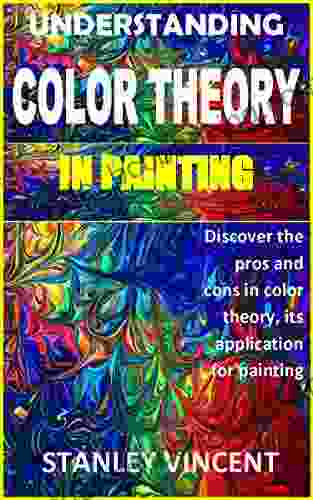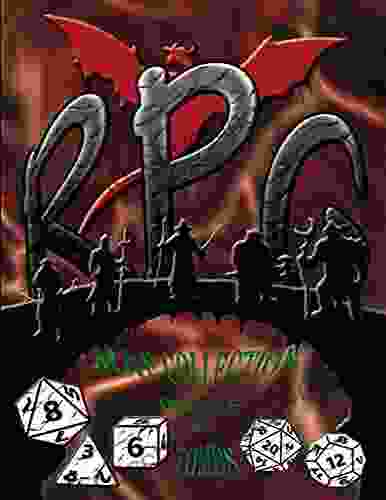Unveiling the Symphony of Colors: A Comprehensive Guide to Color Theory for Painting

Colors, the lifeblood of art, transport us to worlds unknown, evoke emotions with their vibrant dance, and narrate stories that transcend words. In the realm of painting, color theory serves as the maestro, orchestrating harmony and guiding artists toward masterpieces.
The Genesis of Color Theory
The foundations of color theory took root centuries ago, with the pioneering work of artists and scientists. In the 16th century, Leonardo da Vinci explored the interplay of light and shadow, paving the way for the development of aerial perspective. Centuries later, in the 18th century, Isaac Newton delved into the scientific nature of color, unraveling the spectrum through his prism experiments.
4 out of 5
| Language | : | English |
| File size | : | 1232 KB |
| Text-to-Speech | : | Enabled |
| Enhanced typesetting | : | Enabled |
| Print length | : | 12 pages |
| Lending | : | Enabled |
| Screen Reader | : | Supported |
In the 19th century, German poet and natural scientist Johann Wolfgang von Goethe expanded on Newton's work, proposing a psychological approach to color. His influential book, "Theory of Colours," examined the subjective and emotional effects of different hues.
The Color Wheel: A Kaleidoscope of Hues
The color wheel, a circular diagram, serves as a visual guide to the relationships between colors. It consists of three primary colors—red, yellow, and blue—which cannot be created by mixing others. These primary colors form the vertices of an equilateral triangle within the wheel.
Secondary colors—orange, green, and violet—are created by combining two primary colors. They lie midway between the primary colors on the wheel. By mixing a primary color with an adjacent secondary color, we obtain tertiary colors, adding even more depth to the chromatic landscape.
Color Harmony: Striking a Perfect Chord
Color harmony refers to the pleasing arrangement of colors within a composition. It can be achieved through various techniques, including:
- Monochromatic: Using different shades and tints of a single hue.
- Analogous: Utilizing colors adjacent to each other on the color wheel, creating a harmonious blend.
- Complementary: Pairing colors opposite each other on the wheel, yielding a striking contrast.
The Significance of Value: Light and Shadow
Value, the lightness or darkness of a color, plays a crucial role in painting. By modulating values, artists can create depth, form, and dramatic effects. Lighter values advance in space, while darker values recede, bringing a sense of realism and dimension to a work of art.
Value scales encompass a range of hues, from pure white to absolute black, and infinite shades in between. By understanding the interplay of value, painters can manipulate light and shadow, guiding the viewer's eye through their compositions.
Color Temperature: Warmth or Coolness
Color temperature refers to the perceived warmth or coolness of a hue. Warm colors, such as red, orange, and yellow, evoke feelings of energy, passion, and excitement. Cool colors, such as blue, green, and violet, convey a sense of calmness, serenity, and detachment.
By combining warm and cool colors, artists can create a sense of balance and contrast within their paintings. Warm colors can advance in space, creating a sense of proximity, while cool colors tend to recede, enhancing a feeling of depth.
The Psychology of Color: Evoking Emotions
Colors possess an innate ability to influence our emotions and perceptions. Different hues can trigger specific psychological responses, such as:
- Red: Passion, excitement, danger
- Orange: Optimism, joy, warmth
- Yellow: Happiness, hope, caution
- Green: Nature, growth, balance
- Blue: Serenity, trust, coldness
- Violet: Creativity, spirituality, royalty
By understanding the psychological associations of colors, painters can consciously evoke desired emotions within viewers, bringing added depth and meaning to their creations.
The Practical Application of Color Theory
Color theory provides a solid foundation for both traditional and contemporary painting practices. Its principles can be applied in various contexts, including:
- Landscape Painting: Capturing the natural harmonies of colors in nature, from vibrant sunsets to verdant meadows.
- Portrait Painting: Enhancing the realistic depiction of skin tones and facial expressions through careful value modulation.
- Abstract Painting: Exploring the expressive potential of color, independent of representational forms.
Color theory, an indispensable tool for aspiring and established painters alike, unlocks the profound potential of color. By understanding its principles and embracing its practical applications, artists can transform their canvases into vibrant symphonies of hues, evoking emotions, igniting imaginations, and illuminating the world with their creative visions.
Discover the transformative power of color theory and embark on an artistic journey where colors dance, emotions bloom, and masterpieces are born.
4 out of 5
| Language | : | English |
| File size | : | 1232 KB |
| Text-to-Speech | : | Enabled |
| Enhanced typesetting | : | Enabled |
| Print length | : | 12 pages |
| Lending | : | Enabled |
| Screen Reader | : | Supported |
Do you want to contribute by writing guest posts on this blog?
Please contact us and send us a resume of previous articles that you have written.
 Book
Book Novel
Novel Page
Page Chapter
Chapter Text
Text Story
Story Genre
Genre Reader
Reader Library
Library Paperback
Paperback E-book
E-book Magazine
Magazine Newspaper
Newspaper Paragraph
Paragraph Sentence
Sentence Bookmark
Bookmark Shelf
Shelf Glossary
Glossary Bibliography
Bibliography Foreword
Foreword Preface
Preface Synopsis
Synopsis Annotation
Annotation Footnote
Footnote Manuscript
Manuscript Scroll
Scroll Codex
Codex Tome
Tome Bestseller
Bestseller Classics
Classics Library card
Library card Narrative
Narrative Biography
Biography Autobiography
Autobiography Memoir
Memoir Reference
Reference Encyclopedia
Encyclopedia Kumiko Love
Kumiko Love Shelly Palmer
Shelly Palmer Maggie Glisson
Maggie Glisson Rowboat Watkins
Rowboat Watkins Thad Carhart
Thad Carhart Kristine Ellingson
Kristine Ellingson Norihiro Yagi
Norihiro Yagi Kit Sun Cheah
Kit Sun Cheah Peter Hollins
Peter Hollins Louisa J Morgan
Louisa J Morgan Ksenia K
Ksenia K Robert Greene
Robert Greene Summary Genie
Summary Genie Leatrice Eiseman
Leatrice Eiseman Myles Ethan Lascity
Myles Ethan Lascity Kitti Young
Kitti Young Gina Evans
Gina Evans Raymond Coppinger
Raymond Coppinger Knut Svanholm
Knut Svanholm Steve Hilker
Steve Hilker
Light bulbAdvertise smarter! Our strategic ad space ensures maximum exposure. Reserve your spot today!

 Quentin PowellFresh Out of the Oven and Straight Into Your Mouth: A Culinary Adventure You...
Quentin PowellFresh Out of the Oven and Straight Into Your Mouth: A Culinary Adventure You... Lee SimmonsFollow ·3k
Lee SimmonsFollow ·3k Jorge Luis BorgesFollow ·2.2k
Jorge Luis BorgesFollow ·2.2k Ernest J. GainesFollow ·19.9k
Ernest J. GainesFollow ·19.9k Alvin BellFollow ·17.8k
Alvin BellFollow ·17.8k Colin FosterFollow ·12k
Colin FosterFollow ·12k Adam HayesFollow ·3.3k
Adam HayesFollow ·3.3k Dylan MitchellFollow ·9.1k
Dylan MitchellFollow ·9.1k Allan JamesFollow ·14.7k
Allan JamesFollow ·14.7k

 Liam Ward
Liam WardUnleash the Power of Goblin Slayer: Discover the Gripping...
Enter the Shadowy Realm of...

 Eli Brooks
Eli BrooksWalking the Territory: Your Essential Companion for...
Adventure Awaits! Prepare to immerse yourself...

 Floyd Richardson
Floyd RichardsonGoblin Slayer: A Gripping Light Novel Series That Will...
Step into the shadowy...

 Dennis Hayes
Dennis HayesFrom Strategy to ROI: The Ultimate Guide to Driving...
In the dynamic and competitive business...

 Edward Reed
Edward ReedUnveiling the Rich Tapestry of Tennis in Britain: A...
: Tennis - A British Love Affair Tennis, a...

 Michael Crichton
Michael CrichtonEscape into the Thrilling World of "Here and Now" by...
In the tapestry...
4 out of 5
| Language | : | English |
| File size | : | 1232 KB |
| Text-to-Speech | : | Enabled |
| Enhanced typesetting | : | Enabled |
| Print length | : | 12 pages |
| Lending | : | Enabled |
| Screen Reader | : | Supported |










